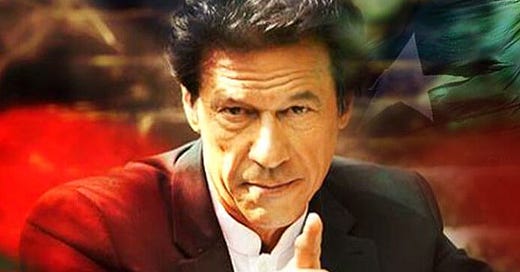What's the big deal with Imran Khan?
The elephant in the room was always in Rawalpindi. Now he is in Adiala. This changes things.
It also changes how we deal with talk about a new deal. Is there one on offer? And from which side? Last week’s airwaves reverberated with such chatter. No one seems to know the exactness of such a deal. But everyone who believes he, or she, is someone, claims to know some other one who knows about the deal. Or the makings of one. Or even the lack of one. So, what exactly is going on?
Plenty, as it turns out.
The epicenter of tumult is PTI itself. In between braving the state’s wrath and the electorate’s fawning approval, the party triumphantly fell into disarray. The cacophony of the likes of Ali Amin Gandapur, Omar Ayub, Asad Qaisar, Barrister Gohar and Sher Afzal Marwat may provide fodder for lazy headlines, but it also hides a deeper cleavage within the party about how to deal with the establishment.
PTI insiders acknowledge – albeit grudgingly – that there exist today at least three different schools of thought within the party.
The first group comprises those who have had long association with Imran Khan and had prominent roles in the PTI government. Many of them had gone underground after the post-May 9 crackdown but remained inflexible in their attitude towards the establishment. They reflect Khan’s thinking but have not had much access to him. This has deprived them of the nuance that may come from speaking to Khan and updating their own software accordingly.
The second group is now part of the post-election parliamentary set-up and is engaging with all key stakeholders including – when needed – the establishment. This group exudes a more tempered approach towards the military high command and is working towards a greater engagement between Rawalpindi and Adiala.
The third group consists of those who are enjoying power as the government in Khyber Pukhtunkhwa. Force of circumstance has made them the most pragmatistic among the three. Nothing manifests this more than the transformation of Ali Amin Gandapur from a firebrand to a softer more congenial brand who is happy embracing those who he fondly raged against.
These three groups form an umbrella over multiple other smaller groupings and cliques that have sprung out from the disarray within the party after the incarceration of Imran Khan. These are in turn garnished with a sprinkling of those who were press conferenced-ed out of the party after May 9 but now want back in.
At the center of it all is the Man in Adiala. What is he thinking?
He cannot but help see the system falling into shape without him in it. With the election of the Senate chairman and deputy, all constitutional offices are finally occupied. The state of the state is now evident for the next five years (in theory at least). If the PML-N, PPP and the establishment play their cards well, and if the Man in Adiala does not, he may have to wait a long time for a comeback.
So far, he has played a strong hand and collected rich electoral dividends. His politics, his persona and his brand, all three are forged in the heat of defiance and aggression. Why should he then forsake his winner-takes-all approach for a deal that may undercut all that he stands for? If ever there was any doubt that Khan may be going soft in his advancing years (a fit 71 years young yet) such doubt was dispelled by the man himself last week. Speaking to journalists during a hearing in his place of incarceration, Khan heaped criticism on the army chief Gen Asim Munir and held him directly responsible for all ills befalling him, his wife – and his country too.
That would mean he is all set to continue barreling ahead on this collision course, and that he will forge his way forward through greater defiance, greater confrontation and greater brinkmanship.
Possible, yes. Probable, no.
There is a reason why Khan is ahead of his opponents in the game of thrones. Huh? You might say. He is in jail; his party is in shambles and his nemesis is the strongest man in the country. True, true and true. And yet, despite all these trials and tribulations, and despite all the denials of his rivals and critics, the fact remains the politics of today’s Pakistan revolves around this one man housed in Adiala jail.
Khan may have arguably been the worst prime minister in terms of governance but when it comes to savvy political moves, he remains a step ahead of others. Which is why he uses aggression as a weapon but retains the option of flexibility and accommodation when needed. But only with the establishment.
The establishment knows this. Its high command reads him. After all, he is their experiment gone awry. So, both are circling each other warily.
Could they deal? Neither would want to do so from a position of weakness. And a win-win situation has not arisen yet. The establishment would like to have some working relationship with the party that commands the electorate, and the party would want a working relationship with those who command the power structure.
Logic may point towards a deal, but reason prevents it. Who has time on his side: the elephant in Rawalpindi, or the one in Adiala?



